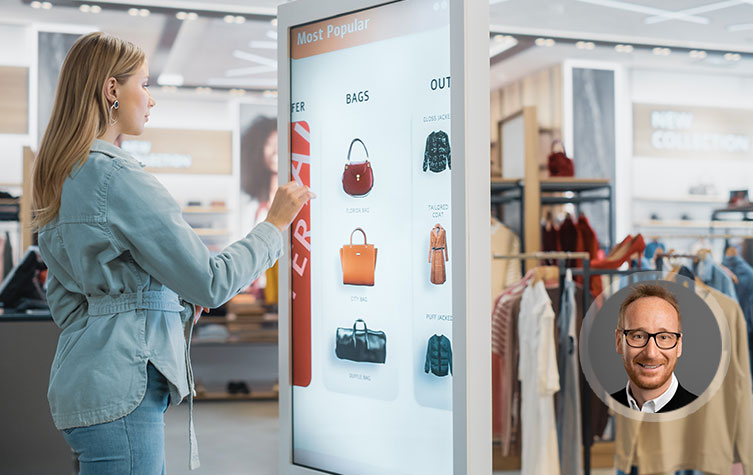Consumer habits have evolved at eye-watering speed, and the indications are that this evolution will continue to accelerate in the years ahead. Yet this transformation of the retail sector has only just begun, and we are still in the very early days of a fundamental shift. In fact, research shows that online might account for just 53% of all sales by 2028. By definition, the other ‘half’ is happening elsewhere! So, the successful retailers of tomorrow must rethink their in-store experience today.
The only way to keep pace – and get ahead of the curve – is to enable your customers to transact with you anywhere and everywhere. If half of the purchases will be online, then the other half will still be made in physical stores. That’s an opportunity as well as a threat. The point is to deploy the technologies needed to ensure that there are no barriers to the sale wherever the customer happens to be.
Rethinking the In-Store Experience
One of the biggest challenges faced in bringing digital capabilities into a physical retail environment is that traditional store processes, employee roles, and technologies were designed for an outdated model - one built around browsing in aisles and queuing at tills. So, retailers must completely rethink the in-store shopping experience, aligning digital technologies to new ways of engaging today’s customers.
This means moving beyond simply adding digital tools to stores and instead redesigning the retail experience entirely. Features such as mobile checkout, AI-driven recommendations, and real-time inventory updates should be integrated into a store environment designed to serve modern shopping behaviours.
The retailer’s task is to make it work seamlessly. Leaders in this space are starting to move beyond omnichannel strategies to embrace unified commerce - an approach that integrates the physical and digital experiences into a seamless customer journey. While omnichannel connected technological touchpoints, unified commerce ensures a frictionless, consistent experience, no matter how a customer chooses to interact with a brand. Unified commerce delivers enhanced in-store experiences to match the convenience of online shopping. This means equipping store associates with real-time data, offering personalised recommendations, and providing customers with easy access to product reviews and inventory levels—all within the physical store environment.
Beyond Technology: A Holistic Approach to Unified Commerce
Achieving true unified commerce is not just about implementing new technology though. Many organisations attempt to solve customer experience challenges with tech alone, but a broader perspective is required. To create a seamless experience, retailers must:
- Connect to Your Customers
Understanding a customer’s unique shopping context is key. Why do they shop with your brand? What influences their buying decisions? Successful retailers focus on attracting, converting, and retaining customers by delivering experiences that align with their needs and expectations. This requires deep insights into customer behaviour, personalisation at scale, and the ability to engage customers at the right moments. - Connect Your Business
Many retailers are structured around siloed departments and disconnected channels, creating inefficiencies in customer engagement. A shift towards unified commerce requires rethinking organisational structures to focus on the entire value chain. Businesses must align operations around how customers truly interact with their brand, rather than internal processes that prioritise individual department objectives. - Connect Your Technology
A strong digital foundation is crucial. Rather than treating e-commerce, mobile, and in-store systems as separate entities, retailers should focus on a technology stack that seamlessly connects data and systems across all channels. This means integrating inventory, customer data, and payment systems into a single, flexible architecture that is agnostic of channels and capable of adapting to evolving customer expectations.
The Future of Retail: Creating a Unified Experience
But unified commerce is far more than just digital transformation. It’s about creating an interconnected experience that seamlessly blends online and offline interactions. By shifting focus from siloed, omnichannel solutions to a truly unified approach, retailers can build a model that aligns with how customers shop today, and prepares them for the evolutions of tomorrow – and beyond.
The journey from omnichannel to unified commerce is not just an evolution though - it’s a redefinition of the entire retail experience. And the retailer’s task is to make it work seamlessly by centralizing all data on prices, inventory, offers, orders, customers and product content into one management system. It means you can easily oversee and manage all your information in a uniform, consistent way across all sales channels.
The retailers that can achieve this, and successfully unify their business, customer engagement, and technology strategies will be best positioned to drive long-term growth, enhance customer satisfaction, and differentiate themselves in a competitive market. Ultimately, they’re enabling their customers to buy what they want, when and where they want to.
That's unified commerce, and that's the future of retail! Get in touch today.

Written by
Gareth Jones
Digital Technology Architect, Retail and Hospitality at Fujitsu

